Though mechanically extremely similar, the Hyundai Ioniq 5 and Kia EV6 are surprisingly different. A primary area where they differ is their interiors. And seeing as this is where you'll spend the vast majority of time with each vehicle, it's important to know which suits you best. So we've spent some time in each and highlighted their design differences, usability, and space to help you figure out which electric hatch might be the best fit.

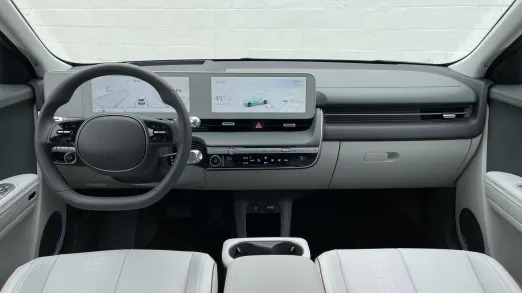
General design
Like their exteriors, the Kia and Hyundai feature distinctly different styling that has distinctly different goals. The Ioniq 5 is clearly designed to be a modern, light and airy machine. The door panels are extremely minimalist, even hiding the grab points behind one simple, blocky armrest. The dash is similarly simple and short. All the space under the dash is open, too, and the center console slides with a big open storage area. The shifter also sits on the column, further opening up the area under the dash. It's unusual placement below the windshield wiper stalk where many cars place a cruise control stalk is definitely unusual, as is its functionality: twist down for Reverse, twist up for Drive, press the button on the end for Park.
All of the materials are muted in color, either black or soft grays (although cars painted Digital Teal can have that color applied to the doors and dash). There are few shiny or flashy trim pieces. It doesn't even have a chrome badge on the steering wheel, just four little squares. Those squares are echoed throughout the cabin, either in printed patterns on the door panels, or perforations in the available leatherette upholstery. At night, the ambient lighting is similarly soft and gentle, with most of it being reflected off the door panels, with the lights tucked behind the armrests.
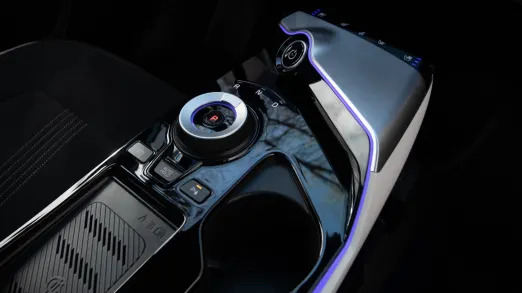
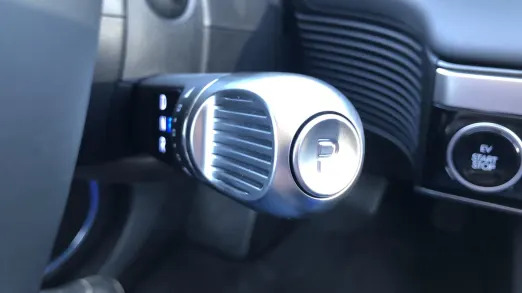
The Kia EV6, particularly in GT-Line trim, is much more flashy and sporty. The dashboard sticks out farther, and it has all kinds of adornments. The top is adorned in stripes, and the middle of the dash features customizable ambient lighting segments. The controls seem to come farther down, and they're nearly met by a tall and long center console. This console features a few controls along with the shifter dial, which practically fits under your palm. It all helps create more of a futuristic cockpit feeling.
The materials are all much darker, but with high contrast. Our model had black faux suede with bright white leatherette trim. There are more bright metallic accents, such as the ring fitted along the lower part of the steering wheel. The low roofline and dark headliner drive home the form-fitting, wraparound cockpit vibe.
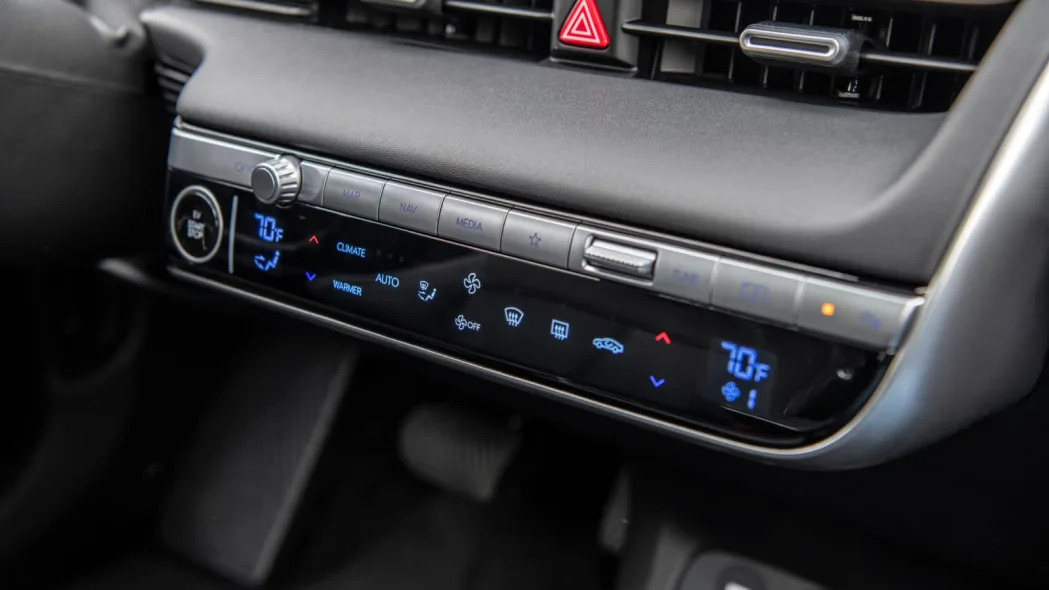


Controls
This is an area where the two EVs start to show that they're related. They both rely on a pair of 12.3-inch screens for instruments and infotainment. They may be skinned differently, with separate color and font schemes, but their layout and functionality are basically identical underneath. They look great in either car, run smoothly and are pretty easy to read. The touchscreens are equally responsive with icons that are easy to hit. Menus aren't overly complicated or deep, so it's an all-around solid experience.
Below the screens are more dedicated buttons, and this is where the two cars diverge. They each have very similar sets of controls, but they're presented differently. The Hyundai (pictured above) has a row of physical shortcut buttons and a volume knob for assisting with infotainment functions. Below that is a bank of touch buttons for controlling most climate functions. Oddly missing from those buttons are heated seat controls. Those require bringing up the more detailed climate menu on the infotainment screen.
The Kia condenses all these controls into one line of touch-sensitive buttons (see video above). Only the climate controls or the infotainment controls can be used at a time. One of the buttons is a dedicated switcher. It's a cool little trick to have these multifunction buttons and knobs, and helps streamline the EV6 cabin’s appearance. In practice, though, it's a little annoying having to bounce between the two if you want to adjust your air temperature followed by the volume. And like the Hyundai, the climate buttons don't encompass everything, so some functions have to be adjusted on the screen.
There’s another odd user experience in the phone charging and connectivity arena. In the Ioniq 5, the wireless phone charger is buried in the bottom of the center console, along with the wired charging ports, making it a bit of a hassle to reach. The EV6 is better with its wireless charger up on the top of the console. Both cars have the issue of no wireless Apple CarPlay or Android Auto, though. This means that you either wirelessly charge or plug in, which is another inconvenience. And it also defeats the EV6’s slight advantage in phone convenience.


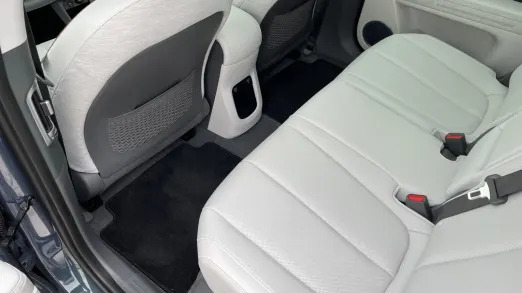
Seats
Seating is definitely tailored to each car's general focus. The Ioniq 5 has the real showstoppers of the pair thanks to its built-in leg rest on the driver seat that's designed to be used in conjunction with the max recline seat back. As good of an idea as this is for sitting around waiting for your electric charge, it won’t be useful for everyone. For a long-legged driver like yours truly, it doesn't extend enough to really provide much support. If you’re shorter, it might come in handy.
One of the other key advantages for the Ioniq is headroom. Its taller roofline means that there's more headroom front and rear – indeed, taller folks might find their hair brushing the Kia’s roof. It also contributes to the Ioniq's lighter, airier feeling.

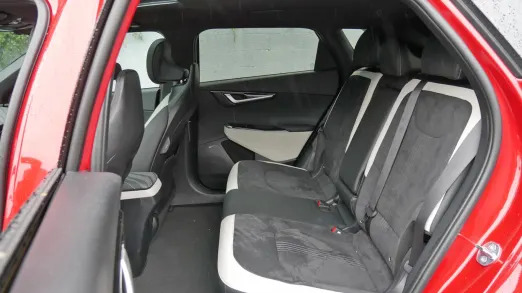
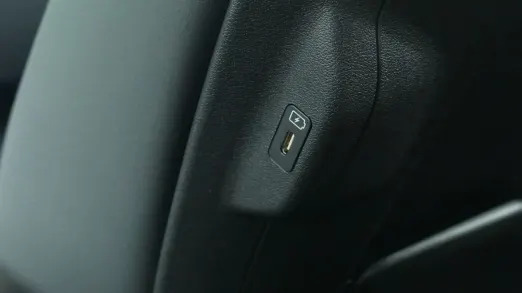
The EV6 lacks much in the way of fancy seating features, but the GT-Line models do have some very sporty faux suede upholstery available. It fits the car's sportier design, but it also helps hold you in place more so you don't slide around when taking advantage of those driving dynamics. The seat design does appear to have a bit more bolstering, but it's not especially noticeable.
Beyond these differences, the two cars' seats are pretty similar. They have a good amount of cushion, though not a lot of lumbar support or much shape. The lower cushions are a little short, but the angle helps provide decent thigh support. Leg and knee room in both rows is enormous, with loads of space of people and rear-facing child seats alike. We also quite like the adjustable recline in the rear seats.
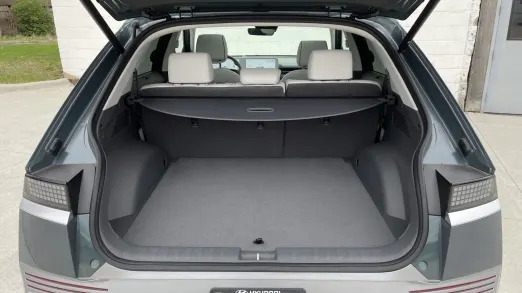

Cargo space
Just as the different body shapes have affected passenger space, the Ioniq 5 and EV6 each have different amounts of cargo space. The Ioniq 5's more conventional and taller design gives it more space. With the rear seats up, it has 27.2 cubic feet, and folding those seats expands space to 59.3. The EV6 has 24.4 cubic feet behind the rear seats and 50.2 with them folded, which still proved big enough to fit all the bags of our standard luggage test (we have yet to test the Ioniq 5).
Conclusion
Objectively, the Ioniq 5 has a slightly better interior. It's a little roomier, and its controls are a little more user friendly. But that matters much less than the subjective aspects. If you're looking for a car that's more of a soothing lounge, the Hyundai is the way to go. But if you're looking for something like the sporty cockpit of a spaceship, the Kia carries your captain's chair. And you can't really go wrong with either.










Sign in to post
Please sign in to leave a comment.
Continue